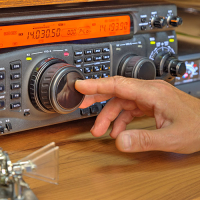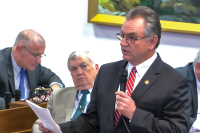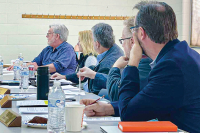Macon residents still waiting on McCoy Bridge plan
A year ago, state officials promised a group of Macon County residents that they would get a cost estimate for what it would take to rehabilitate the McCoy Bridge, a single lane truss bridge that dates from the 1930s.
That cost assessment hasn’t happened yet and now the North Carolina Department of Transportation says the project has dropped in priority because of the state’s budget crisis.
Residents want to save the McCoy Bridge because of its unique character and aesthetic value. The NCDOT, meanwhile, has argued that the bridge is not historic and needs to be replaced with a two-lane bridge with greater weight-bearing capacity. The bridge is seen by some as a symbol of the community’s rural character, something that could be comprised if a bigger bridge replaced it.
In response to opposition from residents to the NCDOT’s plan to replace the bridge, the agency promised it would provide a cost assessment for the bridge’s rehabilitation within the year, and a year is now up. Steve Abbot, communications director for the NCDOT, said that assessment hasn’t been completed and could not provide a concrete timetable for its completion.
The bottom line from the NCDOT’s perspective is that the state’s budget crisis and the I-40 rockslide have made the bridge a low priority.
“The project has been delayed due to the State’s financial crisis and other projects that are funded have been given higher priority for our resources,” Abbot said. “Until we work through the current issues, we will not be setting the project schedule.”
Related Items
According to the DOT, the most current cost estimate for replacing the 290-foot bridge and its roadway approaches is $2.424 million, a figure that does not include any right-of-way acquisition or utility relocation cost.
Doug Woodward, a resident who has championed the McCoy Bridge cause, argues the bridge should be saved and that there is no good reason to put in new two-lane bridge on an access route that only carries about 300 vehicles per day.
School buses and emergency vehicles don’t use the bridge because the NCDOT has downgraded its weight-bearing capacity to three tons, roughly the weight of an SUV.
Pam Williams, the NCDOT’s engineer for the project, said the disagreement between her department and the residents boils down to a policy issue.
“DOT has a policy of not putting in one-lane bridges and they wanted us to look at the possibility of doing that,” Williams said.
Williams said the bridge has been up for historical designation three times and not been included on the register. Without a historic designation the bridge is not likely to be maintained in the state road system. As of 2009 there were only 36 truss bridges left on NCDOT-maintained roads.
“They do consider it an historic and iconic bridge and I understand that, but it is a truss bridge and truss bridges are considered fracture critical. In North Carolina we don’t build truss bridges anymore,” Williams said.
Abbot said that in the case of bridges with strong sentimental value, the NCDOT often uses its bridge relocation and reuse program to move the bridge to a place where it can be maintained and utilized by private or public entities for non-highway uses.
McCoy Bridge came into the NCDOT system in 1960 but it is believed to have been built in the late 1920s or early 1930s, according to Woodward. It is an example of a Pratt Through Truss Bridge, a common technology for early steel span bridges.
Woodward understands that the NCDOT doesn’t want a single span truss bridge in its system, but he pointed out that many states have found ways to preserve and utilize truss bridges. Iowa has over 1,400 truss bridges in operation, Woodward said.
To Woodward, the issue comes down to logic. The bridge is beautiful and it serves a small community with little potential for traffic increases. Why get rid of a nice bridge with historic value when a new bridge isn’t needed?
“If it can’t be rehabilitated adequately there are other ways to bring it up to a load-bearing standard that is not limiting school buses or emergency vehicles,” Woodward said. “The DOT would put a $4.6 million bridge in that location with 80 percent federal funding which would essentially be a concrete slab.”









